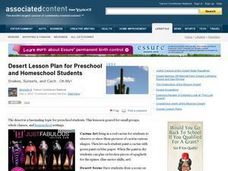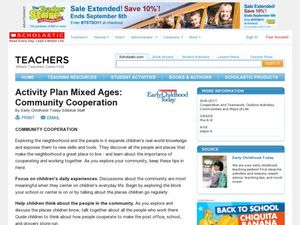Perkins School for the Blind
Let's Pretend
Playing pretend with real objects or concepts is a wonderful way for learners to make object-to-action connections, as well as practice daily living skills. Learners with visual and intellectual disabilities use a wide variety of real...
Curated OER
All Aboard! Railroad Transportation
Students create a picture of a train. In this train lesson, students read Freight Trainand discuss the trains that they see. Students discuss what it would feel like to be a train and play a game where they pretend to be a train. They...
Curated OER
I Think I Forgot Something!
Students examine human health by reading a children's book in class. In this breakfast lesson, students identify the importance of starting the day with a good, nutritious meal. Students read the book I Think I Forgot Something and...
Curated OER
In the Desert
Students explore earth science by completing several environment activities. In this desert lesson, students identify where the U.S. deserts are and what types of wild life inhabit them. Students utilize arts and crafts to create a...
Curated OER
Activity Plan Mixed Ages: Community Cooperation
Students learn how members of communities work together. In this early childhood lesson plan, students explore their neighborhood and discover the people and places that comprise it.
Curated OER
A Teeth Changing Experience
Young scholars research human health by reading an educational story in class. In this oral health lesson, students identify the importance of brushing their teeth and consuming calcium. Young scholars read the book A Teeth Changing...
Curated OER
Where Does Food Come From?
Distinguish between food and non-food items. Recognize that food is obtained from both plant and animal sources. Identify sources for some common animal foods then construct a simple food path from the farm to the consumer.








